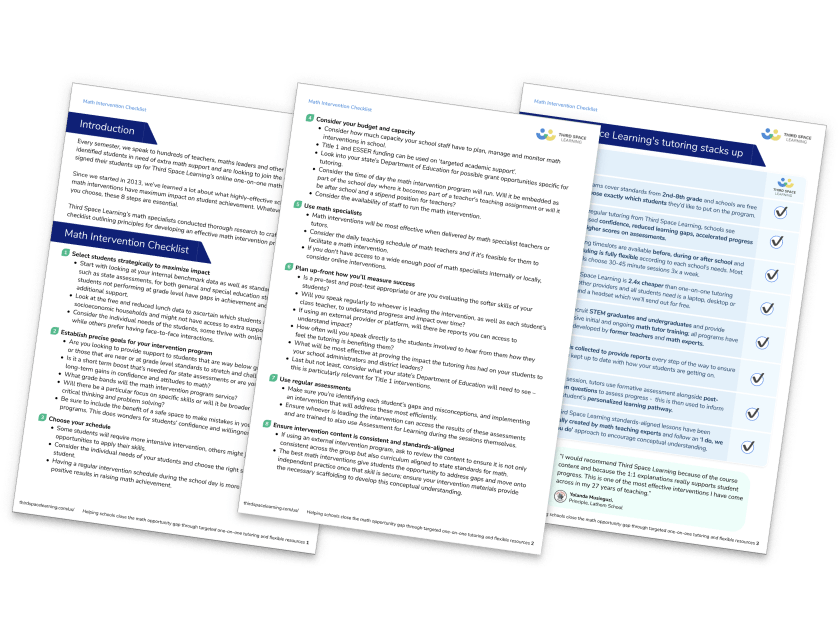When Do ESSER Funds Expire And How Can You Make Them Last Longer?
Originally published: January 2024
ESSER funds expire in September 2024.
However, new guidance means that although states have to commit the federal funding by the end of the 2023/24 school year, they can apply to extend it.
Feeling a bit confused about what this means for State Education Agencies (SEAs), Local Education Agencies (LEAs) and schools? To save you time, we’ve distilled everything you need to know into this super simple blog.
So, let’s dive into deadlines, extensions and what’s next for ESSER funds, including a reminder about how to strategically use ESSER funds in your state.
Spoiler: High-impact tutoring could be just what you’re looking for!
High Impact Tutoring Guide for Schools
An in-depth review of the most popular tutoring approaches to help you choose, plan and fund the most effective one. Helps you make the most of your funding.
Download Free Now!- What is ESSER funding?
- When do ESSER funds expire?
- What is the ESSER funding extension?
- How do you submit ESSER extension requests?
- What is the Department of Education saying?
- What is the White House saying?
- How can you use remaining ESSER funds?
- Looking to use ESSER funds for one-on-one instruction at scale?
- What happens after ESSER funding?
What is ESSER funding?
If you need a reminder, ESSER funding is Elementary and Secondary School Emergency Relief funding, created in 2020 by Congress to address the impacts of the COVID-19 pandemic and mitigate learning loss.
You may also know it as part of the American Rescue Plan (ARP) Act.
ESSER provides approximately $1000 per student or an increase of approximately 8% in overall funding, depending on your state.
When do ESSER funds expire?
ESSER III funds expire on September 30, 2024 (ESSER II funds expired in September 2023). That means 2023/24 is the last school year in which this specific funding program will be available for K-12 education.
Although September 2024 was the intended spending deadline for ESSER funds, bringing to a close the federal government’s original coronavirus response, academic recovery needs will clearly advance beyond that timeframe.

Meet Skye, the voice-based AI tutor making math success possible for every student.
Built by teachers and math experts, Skye uses the same pedagogy, curriculum and lesson structure as our traditional tutoring.
But, with more flexibility and a low cost, schools can scale online math tutoring to support every student who needs it.
Find out moreWhat is the ESSER funding extension?
New guidance released by the U.S. Department of Education has detailed an extension to ESSER funding.
The guidance lists multiple academic recovery interventions they consider ‘permissible’ for an additional 18 months of ESSER funding spending. ‘High-quality tutoring’ is included among these key evidence-based strategies.
Did you know that Third Space Learning provides schools with exactly this? High-quality one-on-one AI math tutoring built for schools by math experts.
Here’s what one of our fantastic schools had to say:
“We just had our first session and it went great! The kids really liked it and felt like they were learning! One even said he finally felt like math was making sense.”
Michelle Craig
Instructional Coach Sherwood Forest Elementary
Washington
This equates to a potential extra year and a half of funding in states that successfully receive an extension for their ESSER funds.
To confirm, while the ESSER III funding still needs to be properly obligated by the statutory deadline of September 30, 2024, it can be used to fund initiatives to help close learning gaps created by disrupted instruction in future years.
How do you submit ESSER extension requests?
The route to extending funding is via a state (SEA or Governor) submitting a liquidation extension request to the U.S. Department of Education.
While remaining ESSER funding levels vary greatly, states have been advised that they have until December 31, 2024 to submit federal liquidation extension requests for ARP Act funds. This means January 2024 is still early in the process for a state to determine if, when, and how to request a liquidation extension.
This is the same liquidation extension request process that has been available under the Coronavirus Aid, Relief, and Economic Security (CARES) Act, and the Coronavirus Response and Relief Supplemental Appropriations (CRRSA) Act.
We’ve included a link to everything currently available for the liquidation extension request process for ESSER funds at the end of this blog.
What is the Department of Education saying?
Here are a couple of excerpts from the new U.S. Department of Education guidance which builds on what we’ve summarized above.
“Grantees must provide a cover letter that explains how the ARP ESSER and/or EANS liquidation extension request contributes to the acceleration of academic success for students, including those furthest from opportunity and with the greatest need. In particular, we encourage grantees to highlight investments in three of the evidence-based strategies that can significantly contribute to improved student performance: increasing daily student attendance; providing high-quality tutoring; and increasing access to before, after, and summer learning and extended learning time.”
Letter from Acting Assistant Secretary, Office of Elementary and Secondary Education, Adam Schott
(9 January 2024)
“As an example of how liquidation extension approvals may work in practice for ARP funds, if a school district (subgrantee) contracts with a tutoring services vendor prior to September 30, 2024, and that contract meets the requirements described in this document, it is permissible for the district to both receive services and liquidate funds for up to 18 months (i.e., the initial 120- day liquidation period, plus the additional 14 months, if approved) past that date under the contract finalized on or before the obligation deadline.”
Frequently Asked Questions (FAQs) for ARP ESSER Liquidation Extension Requests
(Updated 9 January 2024)
Remember, a liquidation extension beyond the 120-day period is not automatic, and no new contracts can be entered after September 30, 2024.
What is the White House saying?
The ESSER funding extension is part of what the Biden administration calls the Improving Student Achievement Agenda. This focuses on three evidence-based strategies to improve student learning:
- Increasing student attendance
- Providing high-dosage tutoring
- Increasing summer learning and extended or afterschool learning time
White House officials including Education Secretary Miguel Cardona explained they had chosen to focus on these because they are proven ways to raise student achievement. “These three strategies have one central goal: giving students more time and more support to succeed,” Cardona said.
The focus on high-dosage tutoring is explained in this statement released by the White House outlining the Improving Student Achievement Agenda.
“When implemented well, high-dosage tutoring can reduce burdens on teachers and complement other school-based activities such as building educator capacity through the use of math and literacy coaches, which research shows can improve student achievement, and professional development to support data-driven instruction.”
Improving Student Achievement Agenda Fact Sheet
(17 January 2024)
How can you use remaining ESSER funds?
It’s never too early to determine how to use your remaining fund allocation to support students. Indeed, the value of this federal funding can be felt far beyond the original September 30, 2024 deadline, and well into 2026!
As well as areas like technology, staffing shortages and professional development, the main focus continues to be supporting mental health and tackling learning recovery needs, through assessments, evidence-based activities etc.
In fact, one of the most effective ways to tackle learning recovery needs and close the achievement gap continues to be tutoring.
High-impact tutoring is eligible among the allowable uses when states request a one-time liquidation extension for their remaining ESSER funds. In other words, ESSER-funded tutoring services can be extended, so long as this has already been obligated by the end of September 2024.
Looking to use ESSER funds for one-on-one instruction at scale?
Your time, money and staff are already stretched, and you’re still looking for a way to close learning gaps. Sound familiar?
Third Space Learning provides effective high-impact one-on-one AI math tutoring programs that could be the answer to allocating your state’s remaining ESSER funds in a cost-effective way.
We’re proud to be one of 32 organizations that received a Call to Effective Action Grant from Accelerate for 2023/24, helping us advance learning opportunities to ensure more high-need learners have access to excellent tutoring.
Want to maximize your funding?
Help students catch up and accelerate math growth with one-on-one math instruction designed to plug individual gaps.
– A proven way to double math progress
– A cost-effective approach to one-on-one tutoring
– A personalized learning pathway for each individual student
Discover how to use ESSER for Third Space Learning today!
– For School Leaders
– For District Leaders
What happens after ESSER funding?
Finally, if you’re wondering what will happen after the U.S. Department of Education’s COVID-relief funding ends once and for all, check out Accelerate’s Beyond Recovery brief from September 2023. It highlights the major grant programs and education funding school districts can use to sustain tutoring initiatives.
ESSER is not the only federal initiative to help in-school interventions.
Further reading:
- Office of Elementary & Secondary Education: Announcements
- Includes Liquidation Extension Request template and Frequently Asked Questions document to support grantees
Do you have students who need extra support in math?
Skye—our AI math tutor built by experienced teachers—provides students with personalized one-on-one, spoken instruction that helps them master concepts, close skill gaps, and gain confidence.
Since 2013, we’ve delivered over 2 million hours of math lessons to more than 170,000 students, guiding them toward higher math achievement.
Discover how our AI math tutoring can boost student success, or see how our math programs can support your school’s goals:
– 3rd grade tutoring
– 4th grade tutoring
– 5th grade tutoring
– 6th grade tutoring
– 7th grade tutoring
– 8th grade tutoring




